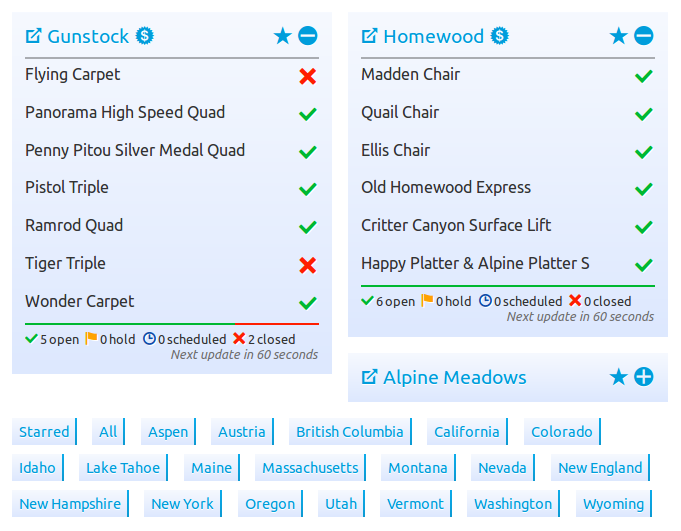liftie
It all started one windy and snowy morning. Nature was being its ambiguous self: snow was promising fresh powder tracks but wind was going to hold up access to the slopes.
I was glued to my computer trying to decide if it’s OK to leave now, or if I should wait some more and let Alpine Meadows crew spin more lifts in addition to the always exciting Magic Carpet. The r key on my keyboard (as in Refresh) was getting a lot of action and I was spending my time watching my browser download completely unnecessary and uninteresting stuff instead of the updated lift status. I thought it should be simpler. And then it hit me: I am actually more or less qualified to make it simpler. And this is how liftie.info was born.
The most important thing to realize when you look at ski resort web pages is that they are not created for skiers or snowboarders. We are rarely interested in discovering our passion, taking the journey to the extraordinary, or not exactly roughing it. No amount of inventive wording can fool us into believing that the icy patches are just packed powder. Even the information on which trail was groomed when is not that high on our list, unless our goal is to avoid them. Mostly we just want to ski and ride.
What we do want to know is which lifts are running, where to park the car, and how much are lift tickets. Alas, this is rarely considered important enough to merit above the fold placement.
Instead we get golf courses, real estate, mini-golf, event calendars and groups & weddings! Or is it group weddings? All is there with the exception of, you know, skiing. May be I should go to a wedding website to find out which lifts are on wind hold?
And with regard to event calendars: they might work a tad better if resorts post something about future events. That torchlight parade last December, while I am sure was great, probably was not memorable enough to be featured in the Upcoming events section till the end of winter.
Randomness of content aside, the form in which that content is served is even worse. If you ever find yourself longing for Clinton years, you should absolutely keep visiting ski resort websites, since this is where all the technologies popular in the '90s have come to retire.
Once you actually guess how the fancy navigation works and by luck or a sheer clicky persistence land on the lift and snow condition page, the joy does not end. Designers seem to compete in the art of careful hiding the very information one expects to find on such a page. The prominent placement is reserved for stock photos of smiling models, who - although dressed for the occasion - probably could not ski or ride if their life depended on it. The multitude of striking colors and the cornucopia of fancy fonts do not help either.
If you keep scrolling down you may find the lift status displayed in the finest possible print. Every resort considers it a point of honor to invent their own way. Okemo goes for subtle, proudly pronouncing: open trails and lifts are in bold. Obviously. Beaver Creek until last week was using 8 pixel by 8 pixel icons to display the status. Which I am sure worked great for them back when computers had screens smaller than today’s phones. Mighty Aspen for inexplicable reason is using a red check icon to mark the open status of its many lifts. It looks like they themselves find it confusing since recently they added a legend. It’s a relief their web developers are not in charge of traffic lights. Telluride does not display lift status at all. Instead they have a live map, which is carefully hidden between weddings and real estate, takes forever to download, almost crashes your browser (Flash anyone?), displays in a minuscule window in the middle of the screen and requires clicking on mysterious icons and hovering over thin red lines to see which lifts might be open.
In most cases you can forget about trying to use those websites on your phone. And if you do it’s going to eat through your monthly data allotment in 3 clicks without actually showing you anything relevant. To tell the truth, some resorts do have mobile pages with their own long list of sins against taste and logic. Most however just want you to install their reward winning app of some sort. Which gives them yet another chance to display stock photos of happy smiley people who would never ski.
To show that we can do better, and not just whine and complain, I give you Liftie - a clean, simple, easy to read, fast, refresh-free ski resort lift status website. It shows lift status and not much else. It works on your computer and on your phone. You can view all the resorts that it supports, or just a single one. And if you frequent 2 or 3 in your area you can star them and create your own page, which you can bookmark.
Liftie is open source so if you don’t find your favorite resort just ask this special geek in your life to add it.
If you have questions or suggestions Liftie is on Facebook, Twitter, Google Plus and, yes, it even has its own e-mail address. Share us and like us so we can efficiently inform the entire world about the status of ski lifts.
And to prove we can be as bad at marketing as people who came up with The Beast loves a good deal here’s our motto: Some places you need to hike to, for everything else there is Liftie.


